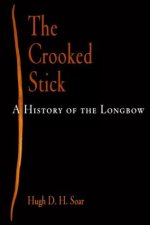 Book Review: The Crooked Stick
Book Review: The Crooked Stick 
 Book Review: The Crooked Stick Book Review: The Crooked Stick  |
 |
Title: The Crooked Stick Publisher: Westholme Publishing, October 1, 2004 Author: Hugh D. H. Soar Reviewer: David M. Cvet |
| "A saggitis hunorum, nos defende Domine" (From the Hunnish archers Lord defend us) The longbow, a pivotal technical development by mankind, had influenced the survival of humankind, as well as the outcome of battles from the earliest days of the medieval period, well into the period of Tudor monarchy till the opening of the 17th century. The longbow still the weapon of the people, required by statute law to own and use a bow with regularity, the skill of the Tudor yeoman archer firmly positioned in history, so feared that at one time they were compared to Attila's Huns (the Hunnish referring to the English and Welsh archers). Hugh D.H. Soar's latest book, "The Crooked Stick" is a comprehensive study and presentation of the amazing history of the traditional longbow. Presenting evidence of the use of archery from Neolithic rock paintings from Cueva de la Arana, Valencia, Spain, of our forebears hunting game to the application of the bow in warfare described in an account of the battle of Crecy, August 26, 1346 found in the French chronicles, "Chroniques" by Jean Froissart, to its continued evolution and staying power as recreational archery, promoted by notables such as King Henry VIII, the archer king, shooting with the longbow at the Field of the Cloth of Gold, 1520 to the creation of archery societies and guilds such as the Society of Finsbury Archers to modern associations active in many countries around the world. The expanse of the book included details on a concoction used to fabricate fire arrows based on an extensive recipe that included exotic materials such as Armeniac, an earthy material from Armenia, and bay salt from the Bay of Biscay. This and numerous other historic gems are invaluable in one developing an appreciation for archery. His writing style is personable, humerous in places, and even a little irreverent at times, combined with his intimate knowledge of the longbow in-depth study, along with extensive notes and references makes this publication required reading for any archer interested in learning more about the context, its place in history and evolution of the longbow. November 2004 |
|
Copyright © 2004 Academy of European Medieval Martial Arts AEMMA |
|